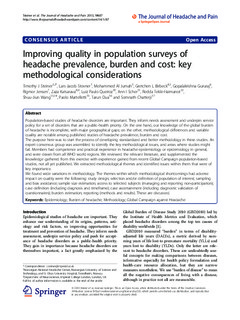| dc.contributor.author | Steiner, Timothy J. | |
| dc.contributor.author | Stovner, Lars Jacob | |
| dc.contributor.author | Al Jumah, Mohammed A | |
| dc.contributor.author | Birbeck, Gretchen | |
| dc.contributor.author | Gururaj, Gopalkrishna | |
| dc.contributor.author | Jensen, Rigmor | |
| dc.contributor.author | Katsarava, Zaza | |
| dc.contributor.author | Queiroz, Luiz Paulo | |
| dc.contributor.author | Scher, AI | |
| dc.contributor.author | Tekle-Haimanot, Redda | |
| dc.contributor.author | Wang, Shuu-Jiun | |
| dc.contributor.author | Martelletti, Paolo | |
| dc.contributor.author | Dua, Tarun | |
| dc.contributor.author | Chatterji, Somnath | |
| dc.date.accessioned | 2019-10-29T14:29:37Z | |
| dc.date.available | 2019-10-29T14:29:37Z | |
| dc.date.created | 2014-01-03T14:42:19Z | |
| dc.date.issued | 2013 | |
| dc.identifier.citation | The Journal of Headache and Pain. 2013, 14 (87), . | nb_NO |
| dc.identifier.issn | 1129-2369 | |
| dc.identifier.uri | http://hdl.handle.net/11250/2625212 | |
| dc.description.abstract | Population-based studies of headache disorders are important. They inform needs assessment and underpin service policy for a set of disorders that are a public-health priority. On the one hand, our knowledge of the global burden of headache is incomplete, with major geographical gaps; on the other, methodological differences and variable quality are notable among published studies of headache prevalence, burden and cost.
The purpose here was to start the process of developing standardized and better methodology in these studies. An expert consensus group was assembled to identify the key methodological issues, and areas where studies might fail. Members had competence and practical experience in headache epidemiology or epidemiology in general, and were drawn from all WHO world regions. We reviewed the relevant literature, and supplemented the knowledge gathered from this exercise with experience gained from recent Global Campaign population-based studies, not all yet published. We extracted methodological themes and identified issues within them that were of key importance.
We found wide variations in methodology. The themes within which methodological shortcomings had adverse impact on quality were the following: study design; selection and/or definition of population of interest; sampling and bias avoidance; sample size estimation; access to selected subjects (managing and reporting non-participation); case definition (including diagnosis and timeframe); case ascertainment (including diagnostic validation of questionnaires); burden estimation; reporting (methods and results). These are discussed. | nb_NO |
| dc.language.iso | eng | nb_NO |
| dc.publisher | BMC (part of Springer Nature) | nb_NO |
| dc.rights | Navngivelse 4.0 Internasjonal | * |
| dc.rights.uri | http://creativecommons.org/licenses/by/4.0/deed.no | * |
| dc.title | Improving quality in population surveys of headache prevalence, burden and cost: key methodological considerations | nb_NO |
| dc.type | Journal article | nb_NO |
| dc.type | Peer reviewed | nb_NO |
| dc.description.version | publishedVersion | nb_NO |
| dc.source.pagenumber | 10 | nb_NO |
| dc.source.volume | 14 | nb_NO |
| dc.source.journal | The Journal of Headache and Pain | nb_NO |
| dc.source.issue | 87 | nb_NO |
| dc.identifier.doi | 10.1186/1129-2377-14-87 | |
| dc.identifier.cristin | 1083528 | |
| dc.description.localcode | © 2013 Steiner et al.; licensee Springer. This is an Open Access article distributed under the terms of the Creative Commons Attribution License (http://creativecommons.org/licenses/by/2.0), which permits unrestricted use, distribution, and reproduction in any medium, provided the original work is properly cited. | nb_NO |
| cristin.unitcode | 194,65,30,0 | |
| cristin.unitcode | 1920,16,0,0 | |
| cristin.unitname | Institutt for nevromedisin og bevegelsesvitenskap | |
| cristin.unitname | Nevroklinikken | |
| cristin.ispublished | true | |
| cristin.fulltext | original | |
| cristin.qualitycode | 1 | |

